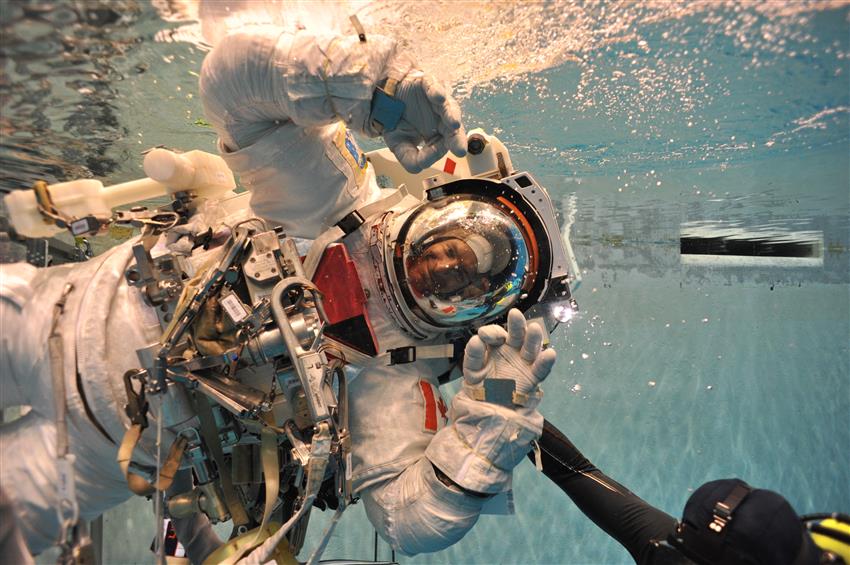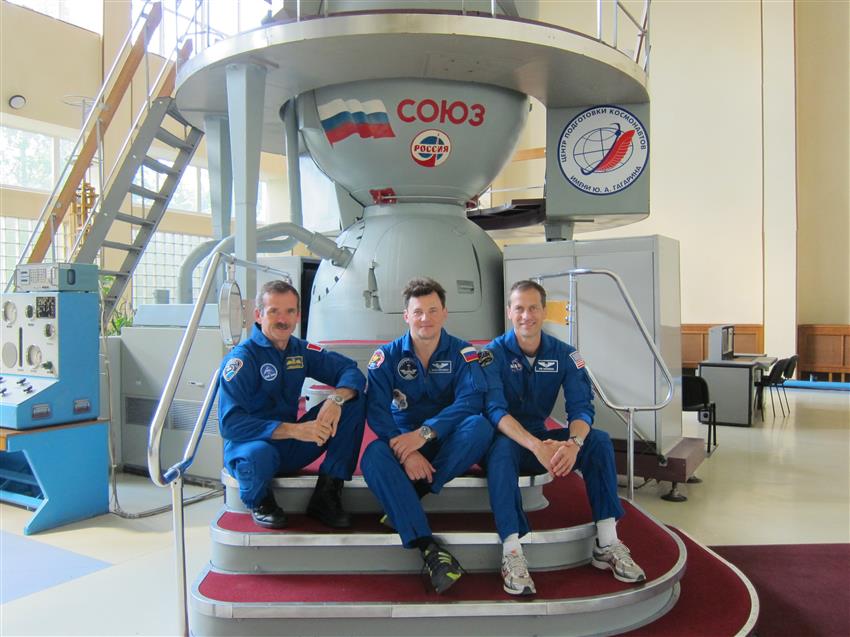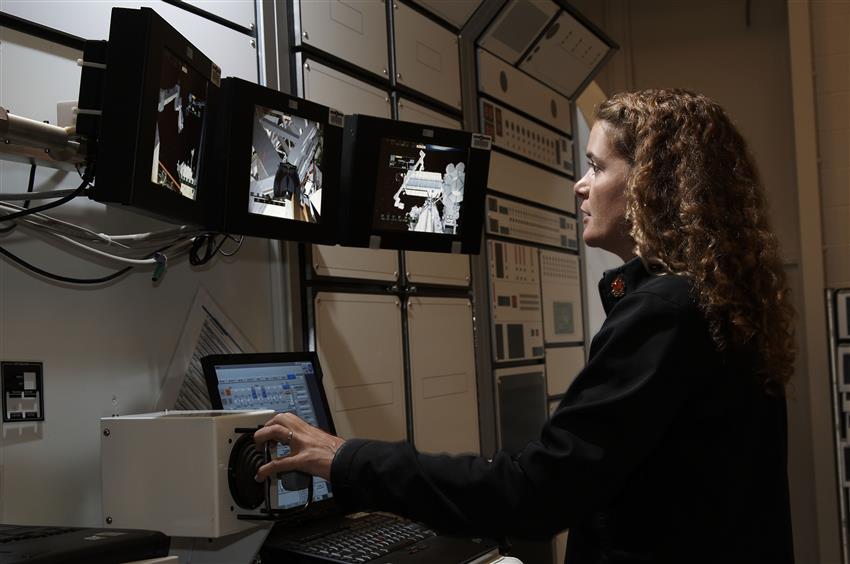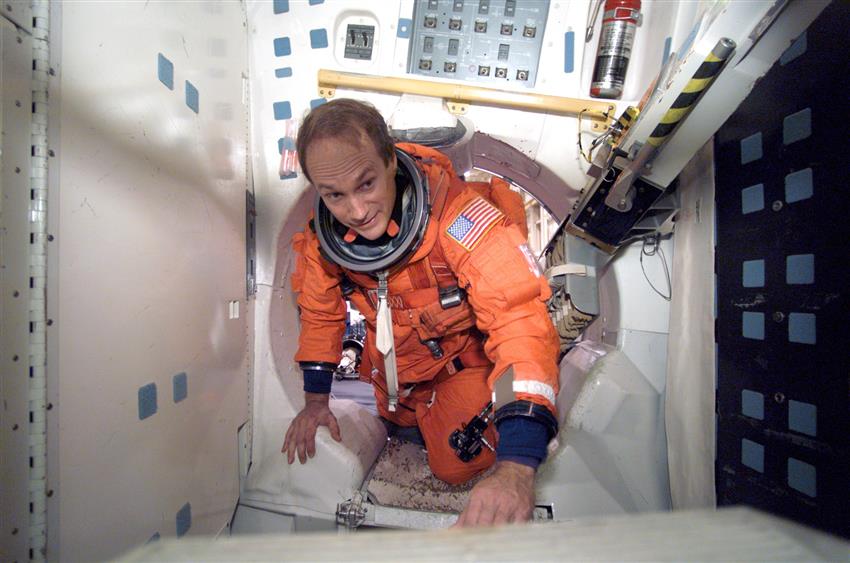Mission-specific training
Training
When the Canadian Space Agency (CSA) selects new candidates, the aspiring astronauts must first go back to school!
All astronauts must follow a three-phase training program:
- Basic training
- Pre-assignment training
- Mission-specific training
Following this three-phased approach, astronauts may go to space to participate in a mission.
When they are assigned to a mission onboard the International Space Station (ISS), astronauts take a training program of approximately two years, custom-made for their mission.
Most of their training takes place at NASA's Johnson Space Center and SpaceX headquarters in Hawthorne, California, using simulators and the virtual reality laboratory. The astronauts also have to travel to:
- ESA's European Astronaut Centre near Cologne, Germany
- JAXA's Tsukuba Space Center in Japan
- Star City in Russia
Spacewalks: training safely

CSA astronaut David Saint-Jacques takes his first dive at NASA's Neutral Buoyancy Laboratory in Houston, Texas, as part of his spacewalk training. (Credit: NASA)
One of the biggest challenges of astronaut training is learning how to perform tasks in microgravity environments.
As a result, before being able to go out into space from the ISS, astronauts have the opportunity to train in different environments:
- in virtual reality
- in a pool
NASA has a Neutral Buoyancy Laboratory at the Johnson Space Center in Houston. This site is equipped with a large 12-metre deep pool that is used to simulate weightlessness.
All members of the same expedition are trained to walk in space in order to be able to replace a colleague, if need be.
Retired CSA astronaut Chris Hadfield prepares to dive into the pool at NASA's Neutral Buoyancy Laboratory. He also demonstrates various features of the spacesuit. (Credit: CSA)
Transcript of the video CSA Astronaut Chris Hadfield in the NBL - Part 2
The pool is big enough to submerge full-scale models of components of the ISS! The astronauts can therefore practise carrying out spacewalks.
Knowing the Soyuz capsule inside out

Astronauts Chris Hadfield (CSA), Roman Romanenko (Russia) and Tom Marshburn (NASA) pose in front of the Soyuz simulator in Russia. (Credit: CSA/Chris Hadfield)
The astronauts must go to Star City, Russia, to learn all about the Soyuz spacecraft. The Soyuz is one of the vehicles capable of transporting humans between Earth and the ISS, alongside SpaceX's Crew Dragon. Boeing's Starliner is also expected to have the same capability in the future. The Soyuz is also used as the Station's rescue vessel in the event of an emergency.
In order to take their seat aboard a Soyuz, the astronauts have to undergo extremely rigorous training. They must master:
- the technical aspects of the spacecraft
- Russian
Then, according to their role on the capsule, the astronauts must learn their tasks during the launch, docking and landing of the Soyuz.
See images of the training See some images of the training in Russia
Operating Canadarm2

Julie Payette during a robotics training session at CSA headquarters in Longueuil (borough of Saint-Hubert). (Credit: CSA)
Operating Canadarm2 is among the most delicate activities of a mission onboard the ISS.
The astronauts must be able to carry out two essential tasks:
- catch and dock unmanned capsules containing supplies such as:
- food
- clothing
- spare parts
- scientific experiments
- research material
- manipulate Canadarm2 in order to move astronauts on spacewalks.
Thankfully, the astronauts can count on the CSA's robotics training centre for adequate training!
Learning about the ISS

Steve MacLean participates in a training session in a model of the ISS as part of preparations for Mission STS-115. (Credit: NASA)
Using the ISS modules
Before travelling to the ISS, the astronauts must know all of the ISS modules like the back of their hand. All ISS partners have full-scale models of their respective modules to train the astronauts.
Plus, during their stay in orbit, the astronauts must conduct scientific experiments. In order to do so, they must learn to use the scientific modules and familiarize themselves with their different systems, namely:
- data management
- electrical power distribution
- environmental control
- thermal control
- communications
Handling emergencies
The crews of the ISS missions must meet in Houston to carry out safety training and simulation activities. The astronauts must be ready to handle the dangers associated with space flight:
- depressurization
- fires
- air contamination
Chris Hadfield and his colleagues Roman Romanenko and Tom Marshburn re-create emergencies in an ISS simulator at NASA's Johnson Space Center in Houston, Texas. (Credit: CSA)
Next step: leave on a space mission!